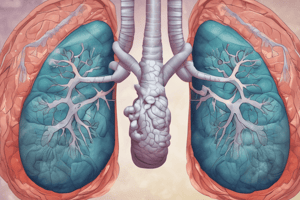Podcast
Questions and Answers
What is Anoxia?
What is Anoxia?
- Absence of spontaneous respiration
- A lung disease caused by inhalation of coal dust
- The absence of oxygen from the body's tissues and organs despite adequate blood flow (correct)
- Loss of the ability to produce normal speech sounds
What is Anthracosis?
What is Anthracosis?
A lung disease caused by inhalation of coal dust
What does Aphonia refer to?
What does Aphonia refer to?
Loss of the ability of the larynx to produce normal speech sounds
What is Apnea?
What is Apnea?
What causes Asbestosis?
What causes Asbestosis?
What is Asphyxia?
What is Asphyxia?
What is Aspiration pneumonia?
What is Aspiration pneumonia?
What characterizes Asthma?
What characterizes Asthma?
What is Atelectasis?
What is Atelectasis?
What is Bradypnea?
What is Bradypnea?
What is Bronchiectasis?
What is Bronchiectasis?
What is the purpose of a Bronchodilator?
What is the purpose of a Bronchodilator?
What does Bronchorrhea refer to?
What does Bronchorrhea refer to?
What is Bronchoscopy?
What is Bronchoscopy?
What is Bronchospasm?
What is Bronchospasm?
What is Cheyne-Stokes respiration?
What is Cheyne-Stokes respiration?
What is Chronic bronchitis?
What is Chronic bronchitis?
What is Croup?
What is Croup?
What does cyanosis refer to?
What does cyanosis refer to?
What is Cystic fibrosis?
What is Cystic fibrosis?
What is Dysphonia?
What is Dysphonia?
What is Dyspnea?
What is Dyspnea?
What is Emphysema?
What is Emphysema?
What does Empyema refer to?
What does Empyema refer to?
What is Epitaxis?
What is Epitaxis?
What is Hemoptysis?
What is Hemoptysis?
What does Hemothorax mean?
What does Hemothorax mean?
What is Hypercapnia?
What is Hypercapnia?
What is Hyperpnea?
What is Hyperpnea?
What is Hyperventilation?
What is Hyperventilation?
Flashcards are hidden until you start studying
Study Notes
Respiratory Conditions and Disorders
- Anoxia: Absence of oxygen in tissues despite adequate blood flow.
- Anthracosis: Lung disease from coal dust inhalation, also known as black lung.
- Aphonia: Loss of normal speech sounds due to laryngeal dysfunction.
- Apnea: Absence of spontaneous respiration, can indicate serious health issues.
- Asbestosis: Lung disease caused by asbestos exposure, common in workers handling asbestos.
- Asphyxia: Loss of consciousness from inadequate oxygen; causes include choking, suffocation, and gas inhalation.
- Aspiration pneumonia: Results from inhaling foreign substances like vomit into the lungs.
- Asthma: Chronic allergic condition causing breathing difficulties, wheezing, and coughing.
- Atelectasis: Collapsed lung due to blockage of air passages or pneumothorax.
- Bradypnea: Abnormally slow breathing rate, under 10 breaths per minute.
- Bronchiectasis: Permanent dilation of bronchi due to chronic infection/inflammation.
Respiratory Treatments and Procedures
- Bronchodilator: Medication that relaxes and expands bronchial passages.
- Bronchorrhea: Excessive mucus discharge from bronchi.
- Bronchoscopy: Visual examination of bronchi using a bronchoscope.
- Bronchospasm: Contraction of smooth muscle in bronchi, causing airway constriction.
Breathing Patterns and Symptoms
- Cheyne-Stokes respiration: Irregular breathing pattern alternating between rapid and slow breaths, often seen in comatose patients.
- Chronic bronchitis: Long-term inflammation of airways from recurrent irritant exposure, commonly from smoking.
- Croup: Acute respiratory infection in children causing barking cough and stridor due to laryngeal obstruction.
Additional Respiratory Conditions
- Cyanosis: Bluish skin and mucous membranes indicating low oxygen levels in blood.
- Cystic fibrosis: Life-threatening genetic disorder causing thick mucus build-up in lungs and pancreas.
- Dysphonia: Difficulty in speaking, including issues like hoarseness and voice changes.
- Dyspnea: Shortness of breath; a symptom of breathing difficulty.
- Emphysema: Progressive lung function loss, primarily due to smoking.
- Empyema: Accumulation of pus in a body cavity, often due to infection.
- Epistaxis: Nosebleed caused by various factors such as dry air or injury.
- Hemoptysis: Blood or blood-stained sputum from lungs or bronchial tubes.
- Hemothorax: Presence of blood in the chest cavity.
- Hypercapnia: Abnormal carbon dioxide build-up in the blood.
- Hyperpnea: Deeper and more rapid breathing than normal, often linked to exertion.
- Hyperventilation: Rapid, deep breathing often associated with anxiety.
- Hypopnea: Reduced depth and rate of breathing.
Studying That Suits You
Use AI to generate personalized quizzes and flashcards to suit your learning preferences.




